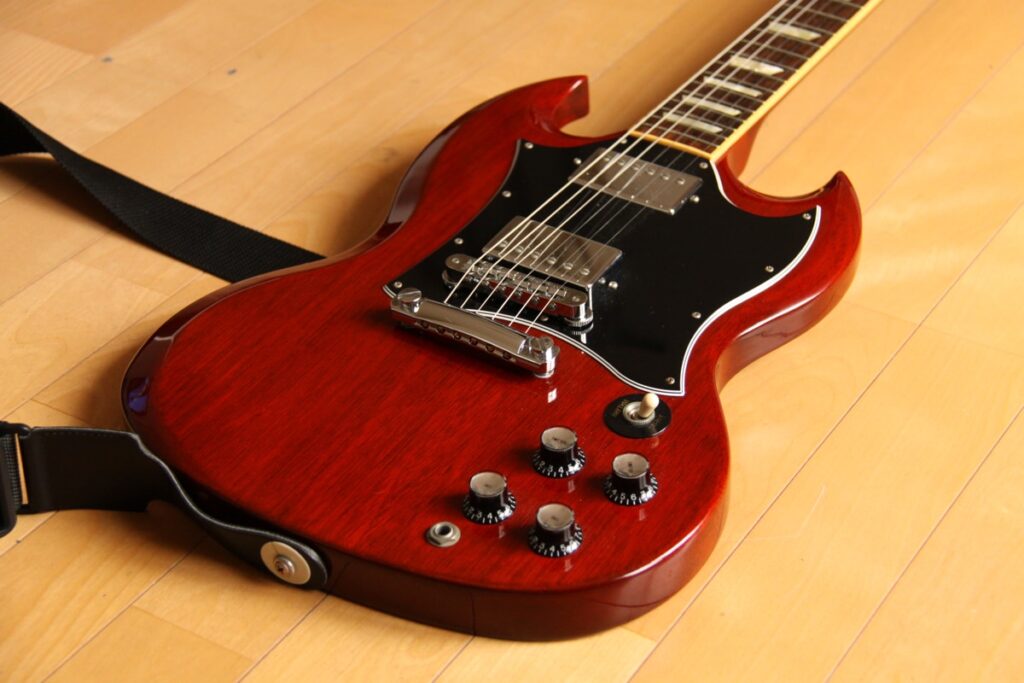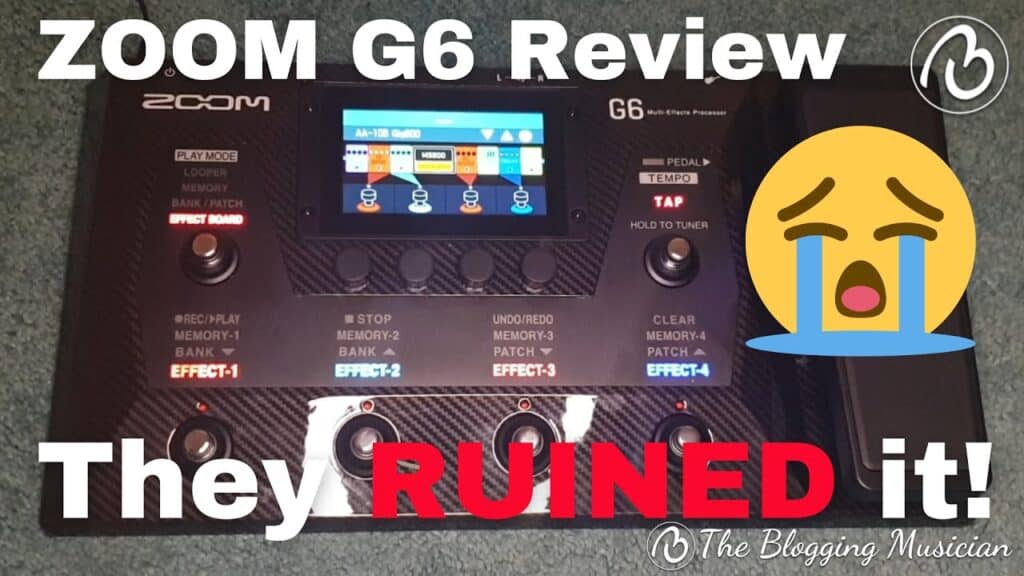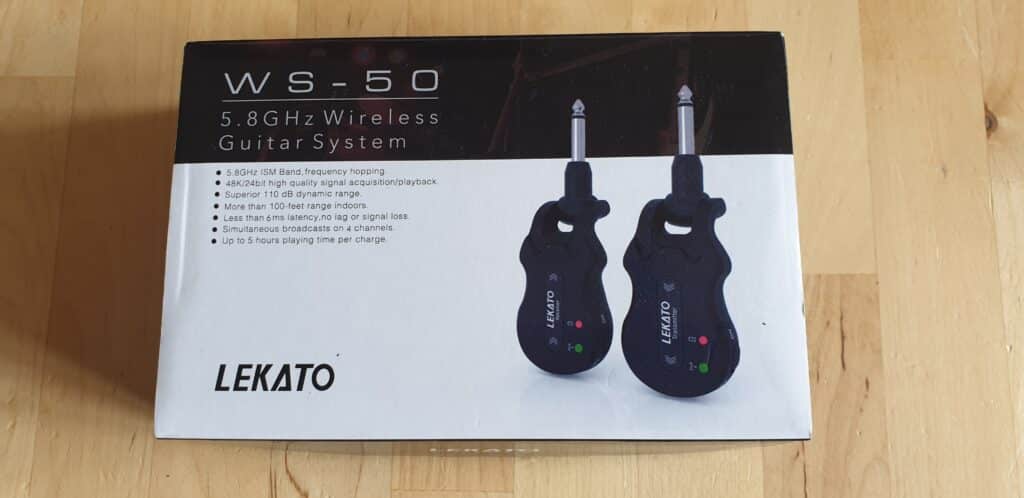After 10 years of being a Les Paul man, and both lately and historically being a Fender Stratocaster devotee… Why am I gassing for a Gibson SG?
So should I buy a Gibson SG? I’ve never owned one, and over the years I’ve justified that decision with many reasons, both from experience and from the grapevine:
It’s a Gibson Les Paul light, right?
Construction-wise, at least, the Gibson SG has a thinner body and lacks a maple cap. It was designed as the ‘new’ Les Paul in 1961 (when unbelievably, Gibson couldn’t sell Les Pauls), so obviously the result is the Gibson SG doesn’t sound or feel like a Les Paul. The Gibson SG is far lighter and mid-focussed with a much narrower frequency response, making it sonically less versatile. Why would you want that?
Les Paul himself didn’t want his name against it.
In fact, he hated it so much, that he was willing to give up his dollar-a-guitar royalty to have his name removed from the new Gibson Les Paul, which was (very unimaginatively) renamed the Gibson SG (Solid Guitar).
The controls are too cramped and fiddly.
Just look at any images of the Gibson SG to see this obvious design flaw. As a player who loves to ride the guitar volume and experiment with tones, the Gibson SG makes this a chore, with the controls being both further away and closer together than even a Les Paul…
That front-facing jack.
…and the above issue is compounded by the output jack which both necessitates a right-angled lead and is far too close to the tone pot for comfort. This and the control layout have always felt rushed and lazy on behalf of Gibson’s design team. What is the benefit of laying out the controls and jack this way?
Pickup contrast.
A 22nd fret neck join necessitates that the neck pickup is closer to the bridge pickup than on a Gibson Les Paul, meaning less differentiation between the two, resulting in less tonal versatility as well as a narrower tonal response described in a previous point.
Neck dive.
Another design flaw, and the result of the same(ish) neck, attached to a lighter body at a different point. Who want’s neck dive? Was the Gibson SG a rush job by Gibson to try and get sales going again on the back of the Strat’s success?
Gibson SGs feel weird, like a long plank of wood attached to a body that almost isn’t there.
I’ve had a Gibson SG Standard in my hands before. It felt very strange. The neck felt too long (although it’s the exact scale length of a Gibson Les Paul), and not at all stable or reassuring. more like a a floppy inflatable guitar In fact, it feels like it’s just a guitar neck, with the body stuck on as an afterthought… with that awful jack socket and control layout to boot.
Did I mention the strap button?
The fastest neck in the world Gibson said. 22 fret body/neck join. Perfect playability and fret access right? Well, not when the strap button is located right on the heel under your hand it isn’t.
It’s Gibson’s answer to a Fender Stratocaster… when I already own a Stratocaster.
Having a double cutaway, a lighter body, and better ergonomics than a Gibson Les Paul doesn’t make it a Fender Stratocaster. As I’ve said a thousand times, design-wise at least, the Fender Stratocaster is the perfect electric guitar. The Gibson SG isn’t even in the same game.
It’s not exactly a looker is it?
The Devil guitar or the Batman guitar doesn’t really sell it for me. I’ve always thought the Gibson SG to be a little School of Rock cheesy-looking. The horns are just too severe, It makes too much of a statement, but at the same time is uglier than an Explorer or a Flying V which both make more of a statement. It’s all a bit odd really. I can’t sum this up more than Angus Young in his shorts. I dunno, it’s all a bit cringeworthy.
Gibson SG Players.
Compared to the Gibson Les Paul and the Fender Stratocaster/Telecaster, the roster of famous SG players is lacking. Angus Young, Toni Iommi, Frank Zappa, Kelly Jones(Stereophonics), and Derek Trucks to name just five. Other players have dabbled (Hendrix, Clapton, even George Harrison), but never elevated it to their guitar of choice, for obvious reasons. That lack of endorsement has played a major factor in my, and many others buying decisions.
That’s quite a convincer for never owning a Gibson SG. However, I still want one. Let me try and make some sense of that statement for you.
The Gibson SG is the perfect alternative to a Gibson Les Paul.
I want a break from Les Pauls, and I currently have the Strat itch scratched with my Fender Player Stratocaster. So for my fix of thick double humbucker action, I started to look at Les Paul alternatives: The Yamaha Revstar, Gibson Les Paul Juniors, and Paul Reed Smith. But there’s a no-brainer right under my nose that’s been in Gibson’s back catalogue almost as long as the Les Paul itself, which even carried the name Gibson Les Paul between 1961 and 1963. That guitar is the Gibson SG.
The Gibson SG has The World’s Fastest neck.
I’m not gonna lie. I love Gibson necks, and Its USA models boast plekked fretwork, meaning no issues with uneven frets. This, combined with the floppier scale length, 22-fret double cutaway body join and a neck radius that doesn’t choke out is getting onto ultimate playability. Could Gibson’s claim be true?
Do I really care about the Gibson SG design issues?
When push comes to shove and you’re in the moment making music, does the location of the controls really matter that much? After a few days/weeks could I get used to the strap button location? Is it really that much of a bother to get a right-angled jack and a grippy guitar strap? Some argue that the SG is designed to be an all-out rock machine to bash away at, zipping across the fretboard at speed, with nothing so trivial as controls to get in the way. I get that.
The Gibson SG is exceptional value for money.
At the time of writing, you can gain access to the real McCoy, a no-compromise Gibson USA Standard instrument for £1500. That’s less than an American Pro II Fender Stratocaster and a LOT less than a Gibson Les Paul Standard, with the only concession being, you get a very nice gig bag rather than the case. There’s just something about owning a USA standard, and the Gibson SG Standard represents the lowest barrier to a piece of history than them all.
Would I take a £2k Gibson Les Paul Standard to the dog and duck to leave on its stand at a gig? No way. But I’d feel a lot more comfortable gigging this.
The Gibson SG is a cool guitar.
Yeah I know I mentioned the SG was cheesy, but guess what? School of Rock and AC/DC are yesterday’s news. Nobody plays SGs anymore, and they’ve become overlooked and underrated, which makes them a little niche, left-field, mysterious, and ultimately interesting and cool again. In these eyes at least they’ve become more attractive, especially in the classic cherry finish.
The Gibson SG is a great compromise between a Fender Stratocaster and a Gibson Les Paul.
For many, their Holy Grail guitar would possess the ergonomics of the Fender Stratocaster with the rich, powerful tones of the Gibson Les Paul, and to a large extent, this is what the Gibson SG achieves. Sure, it doesn’t have the flawless design of the Strat and can’t do many Strat things, but the lightness, the body curves, and the upper-fret access are present and correct (indeed, upper-fret access is even better on an SG). On the other hand, it isn’t quite a Les Paul for tone either, but for many, it’s close enough.
Adding at least some Strat elements to the beloved Gibson tone could be a game-changer. the one-guitar-to-rule-them-all answer.
Gibson SG Tone.
Who said a mid-focussed mahogany-bodied, twin-humbucker tone was a bad thing? Check out Anderton’s Les Paul vs SG vid in which an SG Standard goes against a Murphy lab Custom shop Gibson Les Paul Standard. The Les Paul seemed, dare I say fizzy at times, and lacking the mid-range push of the SG. Also, although the Les Paul has more low-end, is this something you’d want to use, either recorded or live? More often than not, you’ll be shelving those frequencies anyway.
What is clear is that the SG lives in and owns that guitar-friendly, mid-focussed tone spectrum. Isn’t that all that matters?
The Gibson SG looks are growing on me.
Objectively speaking. The Gibson SG is still one of the four classic guitar shapes, along with the Tele, the Strat, and the Les Paul. It’s definitely growing on me, probably because I’ve never owned one, and I’ve spent quite a bit of time oggling them lately.
Pick up an SG Today
You can support the blog by ordering through my Guitar Centre affiliate link here.
Should I buy a Gibson SG?
I’ve laid it out all the pros and cons, gone around in circles, and contradicted myself as only guitars can do (I hope). So should I buy a Gibson SG and why? Do you own one? Do you like them?, or have you avoided them so far as I have? Please let me know in the comments below.




I own two Epiphone SGs (a G310 from 1998) and the more recent Special Satin Vintage E1. I also own a 2013 Gibson Les Paul Studio. While the Studio is my favourite of all my electrics, the SG is my guitar of choice generally.
I love the light weight and the balance (neither of mine have suffered from neck dive), and they are so instantly playable. Tuning has been an issue in the past but I think that has something to do with the string gauge. I recently put a set of 10s on my Special Satin and despite being new and unstretched, there is better tuning stability than the set the guitar came with.
Hi Nick.
Thanks for stopping by, and yes, the Gibson Les Paul Studio is a beast!
I bought an SG Standard years ago but my main frustration was with keeping it in tune! For that reason alone, I sold it on. Having read a few articles about how to fix tuning issues on Gibsons, I took the plunge again in 2019 and got another one.
I love the SG. It’s really comfortable to play and it has many advantages over a Les Paul, not least the fact that it’s weightless in comparison. There are other players associated with the SG such as Terry Kath, Pete Townshend and Frank Zappa that didn’t get a mention. Lots of guitarists use them, just not as their main instrument.
My tip for the SG is to use 9s, any higher gauge will tend to stick in the nut and cause tuning issues. They’re a lot more versatile than people give them credit for, and extremely playable. Go for it!
Thanks for the comment Mark.
With the angled headstock and the strings splayed out, the nut slots are always going to need more attention than a Fender with straight string pull and no neck angle. Also, cutting the slots in the first place is more complex as the slots need to ramp sideways as well as down.
On top of that, replacing a nut on a Gibson is a chore too, as there’s no slot to easily slide it into. Bit of a dogs dinner overall with the design, and one of the reasons I love Fender. Leo solved the issues!
In my experience with Gibsons, I really don’t wanna go 9s, as I think its missing a trick to take advantage of the looser tension and whack some 10s or 11s on there for a bigger tone at the same tension as a Fender. Putting 9s on does work though. Had an Epi 335 which never went out of tune.
Going out of tune is a major thing for me. I never hang onto guitars with an issue.
I have Gibson SGs since 1974. I buy them, play them, sell them. Currently own a newer model. The thumb wheels on the newer models have a hex slot on top to make raising and lowering the bridge height much easier. I put a heavier set of DR Blues strings to play slide. All in all it might be my least played guitar. Only because I have others. As stated, the next might be the fastest neck around.
Thanks Mike. Never liked the way you can’t adjust individual string height on a Gibson like you can on a Strat… but then again, I always achieved a lower action on Gibsons, thanks to the bigger radius and (usually) more attention to the fretwork.
My very first guitar was an Gibson SG and I loved it! I found it way more comfortable than Les Pauls plus you get a lot of tonal options you simply cannot get with an LP.
Thanks for the comment Richard and glad you loved it.
What about an SG with P90’s to avoid any similarity with the Les Paul humbuckers?
I really fancy humbuckers for the extra oomph.
Brian May once said that the Gibson SG was the closest to his Red Special, and that he was looking for a good one.
No higher praise than that!
Unquestionably YES. Had owned a Les Paul for over 20 years when I finally ponied up enough dough to buy a good slide guitar, the SG. At some point, my Les Paul was having some fretwork done, so I lowered the action and changed the tuning on the SG to play it until the Les Paul was done. Oh. my. GOD. Just unbelievable. I did two things, changed out the pickups in the Les Paul (from 490/498 to SD 59’s), and then looked for the right SG to come along. So now I have two SG’s (both have 57’s), one set up for slide, and one for regular playing. Also have American Ultra Tele and Strat. The SG is the best playing of all of them. The neck dive is easily handled by a good strap, I have Franklin 3″ straps on mine. It is lightweight, upper fret access is as good as it gets, and you get that thick humbucker tone. Love mine so much, I’m keeping my eye out for a couple more, a P-90 one, and one with mini humbuckers. And by the way, I’d take issue with the characterization of the players. Derek Trucks may be the most widely respected guitarist alive today, and he has been nearly exclusively an SG player for his whole life. Clapton for me peaked when he was in Cream…..when the Fool was his guitar of choice. Both Duane Allman and Dickey Betts had an SG regularly in their rotation. And as for the harder stuff……is there a more iconic metal player than Toni Iommi? Jimmy Page’s double neck? Is there a more iconic hard rock (differing from metal) guitarist that Angus Young?
Thanks Harry.
And you just reminded of a very famous and influential SG player…. one of my own guitar heroes.
How could I forget Carlos Santana !!!
Oh no! There is an affordable Gibson SG. It is the SG “J”. With his mahogany, body and neck and a matte black over finish, it is incredibly eye-catching. The pick ups are the same cute as the standard S G, and the only difference I found was that it uses klaxon tuners as opposed to Grovers and I just recently picked up a 2013 SGJ model for $600 Canadian. This is now my Daily player.
We’re looking up pictures of the older SG J 40’s, you’ll find that the finish age is quite gracefully, providing more and more character to the instrument.
Hi, Michelle! I own a 2013 SGJ in rubbed white finish and definitely aged gracefully! Only difference I noticed in your comment, is mine has a maple neck, don’t know if all SGJ models have it. But I think all the 2013 ones have.
I can’t afford a Gibson so I bought an Epiphone SG and an Epiphone Les Special, both new. I like them both. The Les Paul has a richer tone but each guitar is great. I’m not a pro, I play for fun so it’s not as big a deal for me as for a pro. I like ‘‘em both. I also have a strat and a telecaster. Each has its own greatness so I alternate playing them. If you have the money, go for a Les Paul. Great tones. I saw and felt no down side to playing the SG. They’re all great guitars in their own way. The strat seems easiest to play during practice, but they’re all excellent newbie guitars if you’re strapped for cash.